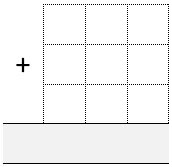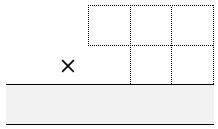3 Identifying the mathematical learning opportunities of number games
As stated at the beginning of this unit, playing number games can be beneficial for developing good social interaction, thinking and problem-solving skills, and can provide motivation for learning.
The games used so far in this unit have offered mathematical learning opportunities – that is, the games helped the students to develop their understanding of specific mathematical concepts and ideas – in this case, number sense. This means that games are not only fun for the students but are also a valid way to learn mathematics.
For example, in Activity 2 the mathematical learning opportunities for the students can be described as:
- learning about place value
- learning about the magnitude of numbers
- learning to use mathematical operations efficiently and accurately
- learning to work with numbers flexibly and fluidly.
Learning about these mathematical ideas is of considerable importance in the curriculum and essential for developing number sense.
The next activity builds on the game in Activity 2. The learning opportunities are extended to working with different operations, understanding number relationships and the effect of different mathematical operations on numbers.
Activity 3: Grid games
Preparation
This series of games follows on from the game ‘Being strategic about numbers’ in Activity 2.
Again there are several variations to choose from. These games are best played in pairs, or with two pairs playing against each other.
For this activity students will again need six-, nine- or ten-sided dice (with numbers 1 to 6, 1 to 9 or 1 to 10), or spinners with ten segments numbered 1 to 10 or 0. You can find templates for spinners in Resource 3.
Instructions for all games
Students take turns to throw the dice (or turn the spinner) and decide which of their cells on the grids to fill in.
This can be done in one of two ways: either fill in each cell as you throw the dice, or collect all your numbers and then decide where to place them.
Playing the games
Game 1
Each of the students draws an addition grid like Figure 3.

Throw the dice nine times each until all the cells are full.
Whoever has the sum closest to 1,000 wins.
There are two possible scoring systems:
- One point for a win. The first person to reach 10 points wins the game.
- Each player keeps a running total of their ‘penalty points’, which is the difference between their result and 1,000 after each round. First to 5,000 loses.
You can vary the target to make it easier or more difficult, or you can get the class to practise using negative numbers (above 1,000 positive, below 1,000 negative) and suggest that the team closest to zero after ten rounds wins.
Game 2
Each of the students draws a subtraction grid like Figure 4.

Throw the dice eight times each until all the cells are full.
Whoever has the difference closest to 1,000 wins.
Here are two possible scoring systems:
- One point for a win. The first person to reach 10 points wins the game.
- Each player keeps a running total of their ‘penalty points’, which is the difference between their result and 1,000 after each round. First to 5,000 loses.
You can vary the target to make it easier or more difficult, perhaps including negative numbers as your target.
Game 3
Each of the students draws a multiplication grid like Figure 5.

Throw the dice four times each until all the cells are full.
Whoever has the product closest to 1,000 wins.
Here are two possible scoring systems:
- One point for a win. The first person to reach 10 points wins the game.
- Each player keeps a running total of their ‘penalty points’, which is the difference between their result and 1,000 after each round. First to 5,000 loses.
You can vary the target to make it easier or more difficult.
Game 4
Each of the students draws a multiplication grid like Figure 6.

Throw the dice five times each until all the cells are full.
Whoever has the difference closest to 1,000 wins.
Here are two possible scoring systems:
- One point for a win. The first person to reach 10 points wins the game.
- Each player keeps a running total of their ‘penalty points’, which is the difference between their result and 1,000 after each round. First to 5,000 loses.
You can vary the target to make it easier or more difficult, perhaps including negative numbers as your target.
Game 5
You could introduce a decimal point and play any of the games above. The decimal point could take up one of the cells, so the dice would only need to be thrown four times by each player. You will need to decide on an appropriate target.
(Source: adapted from NRICH, http://nrich.maths.org/ 6606 [Tip: hold Ctrl and click a link to open it in a new tab. (Hide tip)] .)
Case Study 3: Mrs Mehta reflects on using Activity 3
I have used these different games now in a number of lessons, and with various classes. What I like about them are that the students really get engaged with and practise their sums a lot. The competitiveness and rules of the game make them talk and think strategically. They really think about place value, the magnitude of numbers and the effect of different mathematical operations on numbers. It works for younger and older students.
Sometimes I tell the students which game or operation I want them to use, at other times I let them choose for themselves. Initially, I had thought that the younger or lower-attaining students would stick to what they felt comfortable with doing. But that has proved not to be the case: sometimes they do stay in their comfort zone, but often they really push themselves and go for sums which I would personally never have given them.
I also like that it is self-correcting. Of course mistakes in calculations are made, but they check each other and tell each other when they do not agree. I think playing in pairs against each other helps with that. On the other hand, sometimes I really do think they have to do it for themselves, so I let them play one against one.
I now use these kinds of number games regularly instead of doing lots of practice. I do think they make the students think more about what they are doing mathematically. I have not used these number games yet instead of my normal way of teaching, but I am slowly getting convinced that perhaps I should give that a go because I have realised that all the students have some knowledge of doing sums – no doubt also a lot of misconceptions – but perhaps by using games I might find out what these misconceptions are exactly, and then plan my teaching to address these.
Pause for thought
|
2 Essential characteristics of good games for mathematical learning
